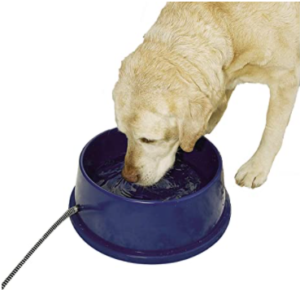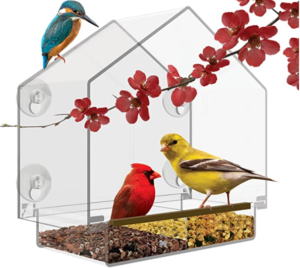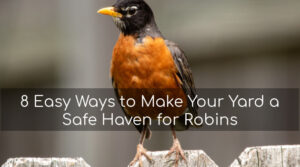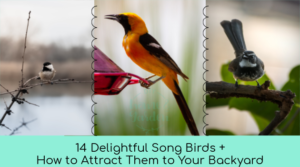What wild bird care should you provide to your feathered friends during the cold months of the winter?
Sure, they can eat the regular, inexpensive seed formula you give them in the summer months. However, the blustery, cold temperatures, and long nights mean that their nutritional needs will increase during the season. They supplement the seed you provide them with protein sources like worms and insects during the summer season. However, they lose access to their protein during cold weather. Additionally, they expend lots of energy in the wintertime feathering their nests to keep warm and foraging.
Besides the birds being hungry, so are the predatory animals–their resources also deplete during winter.
This post will explain the following:
- What to feed wild birds in the winter.
- Which seeds and seed blends to feed wild birds in the winter.
- Where you should place bird feeders during cold weather.
- The importance of water access in the winter.
Winter Wild Bird Care Tips
Your backyard visitors can thrive throughout the winter with your help. Consider these winter wild bird care tips.
My friend who publishes the blog GardensAll caught some incredible footage of her feathered friends feasting during a rare NC snowstorm in 2018. This video allows you to see how eagerly these sweet little guys and gal approach her feeders for sustenance.
1 – Provide your birds with clean drinking water in the wintertime.
Water is essential to every living organism. But access to natural water sources can challenge birds in the coldest areas.
However, your feathered friends lose access to water as the streams and creeks freeze in most parts of the country. If you live in an area with deep freeze potential, please consider investing in a heated water bowl. This gesture is an extreme act of kindness that will keep your birds safer.
Not only will you make life more comfortable for your backyard flock, but you will also bless any critters that remain active during the season.

Of course, if you live in a milder climate, you might not need to make this investment–putting out a fresh bowl of water once the sun comes up will do the trick in some areas. Where I live in North Carolina, this is usually sufficient.
2 – Create a “safe space” for your flock (an essential winter wild bird care tip)
Penn State University’s Agricultural Extension Agency suggests that you reconsider the placement of your feeding stations in the winter.
The landscape of your backyard changes as the weather turns colder. Bushes and trees that provide lush, leafy cover from predators during other months probably provide little foliage. Penn State’s article suggests placing the feeder where you can keep an eye on it from a window, about ten feet from some fashion of protective cover, like an evergreen shrub, when possible.
PSU explains that your songsters won’t feel safe unless they can escape from any perceived threats.

3 – Provide suet cakes for the best wild bird care in the winter.
Ss that suet cakes provide extra fat and energy. Suet is a cake made from fat and seeds. The extra calories help them as they forage, nest, and do all their tricks to keep themselves warm.
Most birdwatchers place suet cakes in cages or suet baskets. But you can also lay it flat in a tray feeder.
Woodpeckers of every variety especially love suet. So if you see these busy birds in your area, consider nailing a suet basket to a tree for them. They continue their work of pecking at trees all year long, so they expend tons of energy doing their “jobs.”
One note about the nature of suet cakes. Because of the fat content, this food source does spoil, especially if you live in a climate that stays warm-ish during the winter season. If suet remains uneaten after a week, please replace it with a fresh offering.
4 – The best winter wild bird seeds by species.
Depending on where you live, you’ll attract different species. The Swain County Extension Center also breaks down the types of nuts and seeds to offer in their winter wild bird care article.
Sunflower seeds
These species love to feast on sunflower seeds:
- Blue jays
- Black-capped chickadees
- Carolina chickadees
- Cardinals
- Purple finches
- House finches
- American goldfinches
- Evening grosbeaks
- Pine grosbeaks
- Nuthatches
- Crossbills
- Tufted titmouse
Peanuts
Technically, peanuts are a legume–a cousin to the bean–and packed with protein. As such, they are a perfect food for wild bird feeding. These species love peanuts:
- Black-capped chickadees
- Nuthatches
- Blue jays
- Woodpeckers
- Cardinals
Millet
Millet is a small-sized whole grain packed full of minerals like calcium (essential for beak health). Smaller species love to dine on this grain, including these:
- Mourning doves
- Almost all sparrows varieties (white-throated, golden-crowned, etc.)
- Goldfinches
- House finches
- Purple finches
5 – Winter wild bird care to the max, custom blending for your feathered friends
If you see that specific species seem to visit your feeder more often than not, you can create your own tempting (to them, not you) seed blend. Add any seeds from the list above to your generic store-blended seed mixture to make winter bird feeding even more attractive. If you put the fat, seeds, and nuts out that they love, they will more likely come by your feeder to enjoy the sustenance you provide.
6 – Peanut butter provides healthy fats for winter bird feeding
Peanut butter contains peanut oil, a healthy fat. Besides that, it gives the birds extra calories. If you don’t like the smell of suet cakes, give peanut butter a try! You can easily add a tablespoon or two to a ledge feeder.
As a craft project, you can find a pinecone, smear it with peanut butter, then roll it into birdseed or crushed sunflowers peanuts. Then, use a large embroidery needle to push through a small hole and a sturdy piece of heavy-duty thread or string. Tie it from a branch, wait, and watch. I tried this, and I attracted chickadees within a few minutes.
7 – Provide protective lodging
The wind easily blows nests out of trees during blustery winter storms, largely because the trees are bare of leaves that provide a windbreak. You might consider supplying some birdhouses that will keep them out of the wind. Try to find a less windy area of the yard with good protection from predatory animals.
The Takeaway: Wild Bird Care Is Perhaps More Necessary in the Winter Than the Summer
It might be easier to feed wild birds in the summertime. However, they need your aid more during the cold of winter. Winter bird feeding might be cold, but it can also be a lot of fun. So feed your feathered friends, sit next to the window with a mug of your favorite coffee, and enjoy the wintertime show.
If you have any extra wild bird care tips, please be sure to share them on social media–we are all ears! Until the next time we meet, have a happy DIY day.



